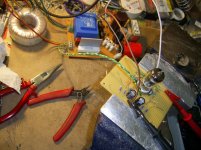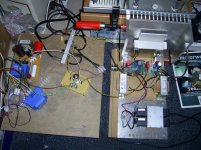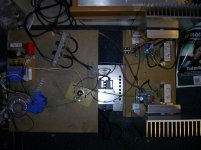Michael,
how to wed Mofo with my 6 foot ribbon?
Resistance with Van den Hul connect cables are aprox 0.8 ohm.
And ribbons are very pleasant when feeding with autoformer.
Trafomaric made for me matched trafo 8ohm:0.2ohm but the highs are poor.
When I connect Trafo as Autotrafo inductance is cutting the low end but mid/high is superb as ( I suppose inductance is to low).
If I make 19v 193t version where resistance is 0.7 ohms can I connect them directly to ribbon with resistor in front of choke for amp to see adequate impedance is it adequate.
Do I need then C2 and R5 ?
Thanks in advance
Zoran
how to wed Mofo with my 6 foot ribbon?
Resistance with Van den Hul connect cables are aprox 0.8 ohm.
And ribbons are very pleasant when feeding with autoformer.
Trafomaric made for me matched trafo 8ohm:0.2ohm but the highs are poor.
When I connect Trafo as Autotrafo inductance is cutting the low end but mid/high is superb as ( I suppose inductance is to low).
If I make 19v 193t version where resistance is 0.7 ohms can I connect them directly to ribbon with resistor in front of choke for amp to see adequate impedance is it adequate.
Do I need then C2 and R5 ?
Thanks in advance
Zoran
next steps with gain stage
Hi to All.
MoFo fever goes on!
I was looking wich gain input i could ad?
Oh, yes of course- long time laying arround unused JAN Philips ECG 5687WB
should used in Wim D Haan Hybrid with LaMos.
So i came up to use single triode for each channel.
Supply gives 254V- on plate is 224V; Plate R:12,2k- gives 115V to Output and
Katode R: 530 Ohm drops ~ 4,74V.
Input is direct coupled with grid refernce to gnd 470k and parr. 100p.
I have tested also near 300V supply voltage, but that needs new set up on resistance- sounds stressed.
And i have GAIN now.
Next step working for better dissipation and changed to FQA40N25.
I have pulled out the IRFP140N(1,7V bias), and started without any changing the FQA's.
Surprise: The Bias was only 0,85/1,0V- ah!,
Is that because part of "fighting agains higher capacitance"?
I pushed it to 2,3V and let it warm up- one was rising to 2,5V, other more stable.
The heat on 159ZC makes me a bit scary, so i was going steps down 2,2V,2,1V
and listen that time.
End up with 2,0V all is running proper for daily use.
Sound is bit more impressing in top end with FQA.
Bottom end has more authority now with gain stage.
Next input is ready for test: a 12AU7 in mu Follower circuit to compare.
Funny to work with MoFo.
Hi to All.
MoFo fever goes on!
I was looking wich gain input i could ad?
Oh, yes of course- long time laying arround unused JAN Philips ECG 5687WB
should used in Wim D Haan Hybrid with LaMos.
So i came up to use single triode for each channel.
Supply gives 254V- on plate is 224V; Plate R:12,2k- gives 115V to Output and
Katode R: 530 Ohm drops ~ 4,74V.
Input is direct coupled with grid refernce to gnd 470k and parr. 100p.
I have tested also near 300V supply voltage, but that needs new set up on resistance- sounds stressed.
And i have GAIN now.
Next step working for better dissipation and changed to FQA40N25.
I have pulled out the IRFP140N(1,7V bias), and started without any changing the FQA's.
Surprise: The Bias was only 0,85/1,0V- ah!,
Is that because part of "fighting agains higher capacitance"?
I pushed it to 2,3V and let it warm up- one was rising to 2,5V, other more stable.
The heat on 159ZC makes me a bit scary, so i was going steps down 2,2V,2,1V
and listen that time.
End up with 2,0V all is running proper for daily use.
Sound is bit more impressing in top end with FQA.
Bottom end has more authority now with gain stage.
Next input is ready for test: a 12AU7 in mu Follower circuit to compare.
Funny to work with MoFo.

Attachments
Greetings to all. I am in the process of building my MoFo 19V. I already have all the components. It is fun and educational, especially through this web page. It's my first attempt to build an amplifier in my life, and I'm already in the fourth decade, so I go slowly, especially because I'm assembling it point by point. MOFO is a great motivation to start. I have some experience welding, changing resistors and capacitors, measuring with DMM, adjusting trimmers and so on, very basic things. I have a question. Being MOFO a power buffer amplifier, with some resemblance to the Firtswatt F4, it is possible to use the high gain output (speaker outputs) of a small conventional amplifier with MOFO, instead of a preamplifier, as you can choose to do with the F4 ?. Has anyone tried that option ?. What do you think of that alternative? It's possible?. Is any modification needed? I am clear about the convenience of a preamplifier with high gain, but the question is about using another small power amplifier (in fact it is an integrated amplifier) to "push" MOFO. I have a Kenwood KA2002, with 13 watts RMS per channel at 8 Ohms to test MOFO when I finish it (while deciding which DIY preamplifier I will build as a couple), but I would like to know your opinions. For reference, I have a modified FE206E Fostex speakers, in a DIY enclosure. They are very efficient. I used them previously with a Decware SE84C amplifier of 1.8 watts per channel, and that was enough for me, in my room. Thank you M. Rothacher and DIYAudio enthusiasts.
Sorry i will learn how to send pics one day.
Steve.
A nice pair of monoblocks.
Do you have a link to the power supply you used.tia.
I, too, have always heard that painting sinks is a bad idea as it greatly reduces the emissivity factor compared to black anodize. There is a nice table of emissivity factors that includes raw and anodized aluminum. I'm not quite sure what to make of the "aluminum paint" (highly variable at 0.27-0.67) and "paint" (0.96) entries in the table, though...
There are high emissivity paints that are better than anodized aluminum which is about 0.9 according to tables.Micro blasting the contact surface where the component mounts to is a bad idea.There you want as smooth a surface as possible.I would sand that surface with successively fine grit sandpapers (wet and dry type) with the paper on a flat piece of glass.Then you would paint the radiating surface only with high emissivity black paint.Sounds like a lot of work but that will give you the best possible outcome.Whether or not you consider it overkill is up to you.
Being MOFO a power buffer amplifier, with some resemblance to the Firtswatt F4, it is possible to use the high gain output (speaker outputs) of a small conventional amplifier with MOFO, instead of a preamplifier, as you can choose to do with the F4 ?. Has anyone tried that option ?. What do you think of that alternative? It's possible?. Is any modification needed? I am clear about the convenience of a preamplifier with high gain, but the question is about using another small power amplifier (in fact it is an integrated amplifier) to "push" MOFO. I have a Kenwood KA2002, with 13 watts RMS per channel at 8 Ohms to test MOFO when I finish it (while deciding which DIY preamplifier I will build as a couple), but I would like to know your opinions. For reference, I have a modified FE206E Fostex speakers, in a DIY enclosure.
I asked the same question, because I didn't have a high gain preamp, but an amp with a volume control. The answer is the MoFo is greatly affected, sound quality wise, by the preamp and whatever comes before the MoFo. If you have a high quality 2 or 3 watt amp, like a 2A3 or 45, then it might be worth it.
I don't think it will hurt to experiment, but just keep your hopes in check.
I spent another 2 months building a high gain preamp (BA3-PRE) and it was worth it.
The F4 manual give nice ideas, and there are existing preamps with high gain. Just have to look around.
Vince
Thanks a lot Vince!I asked the same question, because I didn't have a high gain preamp, but an amp with a volume control. The answer is the MoFo is greatly affected, sound quality wise, by the preamp and whatever comes before the MoFo. If you have a high quality 2 or 3 watt amp, like a 2A3 or 45, then it might be worth it.
I don't think it will hurt to experiment, but just keep your hopes in check.
I spent another 2 months building a high gain preamp (BA3-PRE) and it was worth it.
The F4 manual give nice ideas, and there are existing preamps with high gain. Just have to look around.
Vince
Great idea! Do you consider the possibility of constructing a mu follower with tube ECC89(6N24P) or ECC84(6N14P) in conjunction with MoFo? I think, MoFo is the simplest and most elegant solution for a hybrid amplifier.Next input is ready for test: a 12AU7 in mu Follower circuit to compare.
Maybe black oxidizing? Problem with paint is it can seal in heat and not let the heat sink dissipate as effectively.
Not sure this will work. Maybe one of the chemists here can comment.
Anodizing of aluminum is described in detail on various sites on the Internet, there is a video on YouTube. Probably not worth it in this thread. It is enough to drive in the search.
There is another method that is easier - to perform chemical oxidation of aluminum. To do this, you need sodium hydroxide for the primary treatment and directly the composition for the blackening: Ammonium chloride and Ammonium orthomolybdate. The color can be adjusted from gray to black. But here we need to take into account that the more saturated black the thicker the film is obtained, it also acquires a non-uniform texture (depends on the composition of aluminum and the elements in it of impurities). It turns out a thicker oxide film with good thermal conductivity and excellent dielectric properties, much stronger than when staining anodizing, but with a uniform coating.
Victor,
Could a 2P29L DHT tube be used here as well.
Steve.
2P29L is what I use , cleaner and much less microphonic than 4P1L . If more gain is required , 6E5P makes a good driver for a hybrid
cheers
316a
Anodizing of aluminum is described in detail on various sites on the Internet, there is a video on YouTube. Probably not worth it in this thread. It is enough to drive in the search.
There is another method that is easier - to perform chemical oxidation of aluminum. To do this, you need sodium hydroxide for the primary treatment and directly the composition for the blackening: Ammonium chloride and Ammonium orthomolybdate. The color can be adjusted from gray to black. But here we need to take into account that the more saturated black the thicker the film is obtained, it also acquires a non-uniform texture (depends on the composition of aluminum and the elements in it of impurities). It turns out a thicker oxide film with good thermal conductivity and excellent dielectric properties, much stronger than when staining anodizing, but with a uniform coating.
Sounds interesting - Do you have a more precise prescription or a reference?
- Home
- Amplifiers
- Pass Labs
- Build This MoFo!


